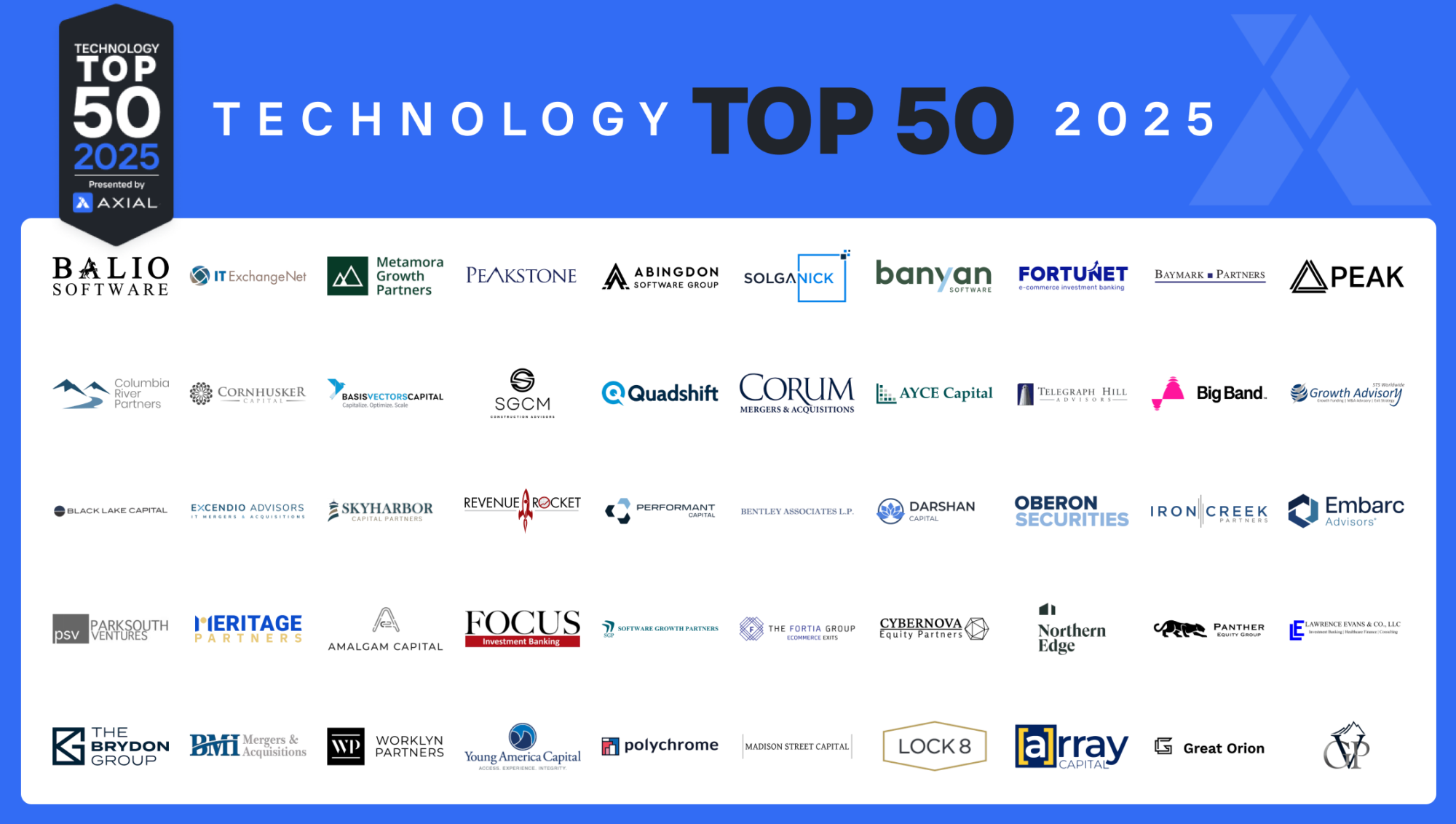
The Top 50 Lower Middle Market Technology Investors & M&A Advisors [2025]
Technology remains a steady presence in the lower middle market, representing ~13% of deals brought to market via Axial over…



Sales is a numbers game. Because only a certain percentage of deals close, building out the top of the funnel with opportunities is key for any salesperson looking to reach quota.
A salesperson is never focused solely on any one deal. Even the biggest, most promising contract of a sales executive’s career must be juggled along with prospecting and nurturing existing leads.
For advisors, this same mindset should apply, to an even greater degree. While a salesperson might close upwards of 10-20% of leads, the closing rate for M&A opportunities evaluated can be as low as 1%.
“You’re not getting a regular paycheck. It’s an eat what you kill phenomenon,” says Tom Schramski, president and managing partner of healthcare M&A advisory firm VERTESS.
“Even when you’re working really hard on a particular deal, you can’t let business development slide. That’s where the danger comes in.”
Being opportunistic isn’t enough.
“It’s very easy for firms to suffer through cycles of feast and famine if they neglect prospecting activities as they go about their day-to-day deal management processes,” says Dexter Braff, president of healthcare M&A advisory firm The Braff Group. “Accordingly, even when our pipeline of current clients is high, we continue to support and emphasize multi-prong development initiatives.”
We talked to Schramski, Braff, and Joan McGeough, CMO at The DAK Group, a middle market investment bank, for tips to build out your top of the funnel more effectively, nurture leads, and close more deals more quickly.
1. Map out your current and upcoming engagements.
Schramski visually maps out his current and upcoming engagements on a calendar to show what he has going on now and what’s in the pipeline. “How does next February look? What do I have that’s approaching conclusion in 2017? When you make it visual, you may see that there are six months where not much is going to close or happen.” Once you’ve identified lower-volume time periods, you can adjust your strategy accordingly.
While each bank may approach it differently, incorporating your communications pipeline into your engagements pipeline will help to better align your sales and marketing efforts. Says McGeough, “We create an annual marketing and business development plan that is executed monthly and balanced along with client work. We operate in a team environment to ensure we accomplish both.”
2. Schedule regular time for outreach.
Says Schramski, “Every week, I identify people I’m going to call — these might be people I’ve had prior contact with or have been referred to. I do this even if I know that bringing them aboard may not be imminent.” He sets aside time in his calendar to make sure that the calls happen. “It has to be a habit that you keep regardless of what stage of the lifecycle you’re in for other deals.”
Your outreach may be over the phone or via email or Axial message, depending on the lead. Regardless, be sure to make a warm introduction that is unique and thoughtful, as opposed to a quick copy and paste.
Says McGeough, “The best strategy we have found is to reach out to CEOs with a very targeted conversation about something that relates directly to their business or industry. This can often take multiple touch points to get a response, but each time we touch them we are sharing knowledge and expertise while building awareness.”
3. Get to know the CEO.
“We take a consultative approach to nurturing our relationships with CEOs,” says Braff. “Our development efforts are not about asking CEOs if they’re interested in selling. It is about getting to know their businesses, their opportunities for growth, and their personal goals and objectives so that we can combine this information with our knowledge of the M&A dynamics of the sectors we cover. In so doing, we can then help executives pinpoint the very best time for their company to test the market.”
4. Produce high-quality content.
“Content is a big deal,” says Schramski. Every other week, VERTESS sends a newsletter featuring content about industry trends, changes in the marketplace, exit timelines, or other relevant topics. They also guest write for other publications to increase exposure among CEOs.
“We almost always get somebody who responds to the newsletter. We’ll follow up with a low-key note asking them what they’re thinking about. Sometimes people want to do a transaction next week, but most of the time they think they’ll be ready in a few months. I ask them when would be a good time to reach out next, and put it my calendar.”
5. Balance tech with traditional means.
Technology can make business development efforts more systemized, but don’t neglect traditional outreach.
“We have always relied on a robust contact management system to coordinate our efforts,” says Braff. “As mobile access has exploded, we have devoted far more resources to internet based emails, webinars, and market analysis distribution. That said, we understand that none of this is a substitute for more personal face-to-face (or phone) encounters.”
6. Speak at events.
VERTESS speaks at both industry-specific and deal professional events through organizations like Axial, AMAA, and ACG. While many advisors go to trade shows, Schramski finds that trade shows “are often not a good use of time. CEOs often don’t want to be seen talking to advisors in front of their competition” — that’s how rumors get started. If you have the budget, “consider hosting your own unique event around the trade show, like a breakfast for CEOs. It’s your responsibility to create an intimate environment where people selling their businesses will feel comfortable.”
7. Think long-term.
“We view business development as an overarching discipline that integrates directly with marketing,” says McGeough. “We use a strategic marketing approach to generate leads, build awareness, and nurture and educate centers of influence as well as CEOs.
“By combining multiple touches of very targeted email, social media, PR, direct mail, and speaking engagements, we build name recognition that warms up our audience — they get to know us and the value we can provide. Each marketing touch provides pertinent content that they can use in their business. We combine this with follow up phone calls and 1 on 1 meetings to deepen the relationship.”
It may take weeks or months or even years to nurture a CEO to the point where he or she is ready to sign an engagement letter. Diligent follow-up and persistence is crucial.
Business development is “like an exercise regimen. Every week, you have to do something,” says Schramski. “If you exercise in a way that’s organized and make sense, you’ll achieve your goal: get stronger or improve your endurance or lose weight, whatever it is. When people struggle with exercise, it’s because they don’t pay attention to what’s essential.” The same is true for deal professionals. Keep your eye on the ball and don’t give into the temptation to put BD aside during a busy spell. Your future self will thank you.
